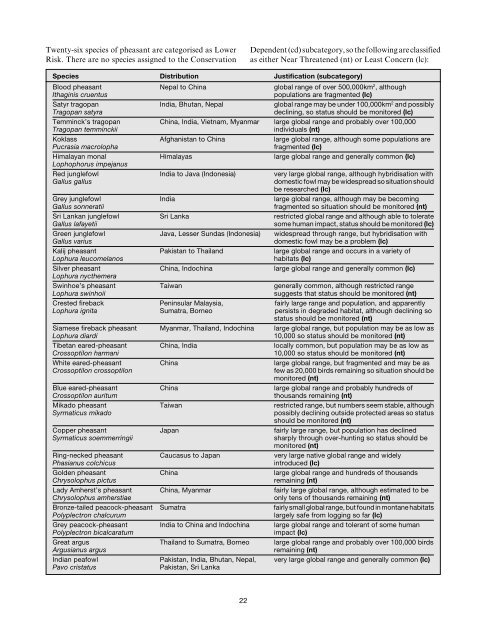Pheasants: Status Survey and Conservation Action Plan ... - IUCN
Pheasants: Status Survey and Conservation Action Plan ... - IUCN
Pheasants: Status Survey and Conservation Action Plan ... - IUCN
You also want an ePaper? Increase the reach of your titles
YUMPU automatically turns print PDFs into web optimized ePapers that Google loves.
Twenty-six species of pheasant are categorised as Lower<br />
Risk. There are no species assigned to the <strong>Conservation</strong><br />
Dependent (cd) subcategory, so the following are classified<br />
as either Near Threatened (nt) or Least Concern (lc):<br />
Species Distribution Justification (subcategory)<br />
Blood pheasant Nepal to China global range of over 500,000km 2 , although<br />
Ithaginis cruentus<br />
populations are fragmented (lc)<br />
Satyr tragopan India, Bhutan, Nepal global range may be under 100,000km 2 <strong>and</strong> possibly<br />
Tragopan satyra<br />
declining, so status should be monitored (lc)<br />
Temminck’s tragopan China, India, Vietnam, Myanmar large global range <strong>and</strong> probably over 100,000<br />
Tragopan temminckii<br />
individuals (nt)<br />
Koklass Afghanistan to China large global range, although some populations are<br />
Pucrasia macrolopha<br />
fragmented (lc)<br />
Himalayan monal Himalayas large global range <strong>and</strong> generally common (lc)<br />
Lophophorus impejanus<br />
Red junglefowl India to Java (Indonesia) very large global range, although hybridisation with<br />
Gallus gallus<br />
domestic fowl may be widespread so situation should<br />
be researched (lc)<br />
Grey junglefowl India large global range, although may be becoming<br />
Gallus sonneratii<br />
fragmented so situation should be monitored (nt)<br />
Sri Lankan junglefowl Sri Lanka restricted global range <strong>and</strong> although able to tolerate<br />
Gallus lafayetii<br />
some human impact, status should be monitored (lc)<br />
Green junglefowl Java, Lesser Sundas (Indonesia) widespread through range, but hybridisation with<br />
Gallus varius<br />
domestic fowl may be a problem (lc)<br />
Kalij pheasant Pakistan to Thail<strong>and</strong> large global range <strong>and</strong> occurs in a variety of<br />
Lophura leucomelanos<br />
habitats (lc)<br />
Silver pheasant China, Indochina large global range <strong>and</strong> generally common (lc)<br />
Lophura nycthemera<br />
Swinhoe’s pheasant Taiwan generally common, although restricted range<br />
Lophura swinhoii<br />
suggests that status should be monitored (nt)<br />
Crested fireback Peninsular Malaysia, fairly large range <strong>and</strong> population, <strong>and</strong> apparently<br />
Lophura ignita Sumatra, Borneo persists in degraded habitat, although declining so<br />
status should be monitored (nt)<br />
Siamese fireback pheasant Myanmar, Thail<strong>and</strong>, Indochina large global range, but population may be as low as<br />
Lophura diardi<br />
10,000 so status should be monitored (nt)<br />
Tibetan eared-pheasant China, India locally common, but population may be as low as<br />
Crossoptilon harmani<br />
10,000 so status should be monitored (nt)<br />
White eared-pheasant China large global range, but fragmented <strong>and</strong> may be as<br />
Crossoptilon crossoptilon<br />
few as 20,000 birds remaining so situation should be<br />
monitored (nt)<br />
Blue eared-pheasant China large global range <strong>and</strong> probably hundreds of<br />
Crossoptilon auritum<br />
thous<strong>and</strong>s remaining (nt)<br />
Mikado pheasant Taiwan restricted range, but numbers seem stable, although<br />
Syrmaticus mikado<br />
possibly declining outside protected areas so status<br />
should be monitored (nt)<br />
Copper pheasant Japan fairly large range, but population has declined<br />
Syrmaticus soemmerringii<br />
sharply through over-hunting so status should be<br />
monitored (nt)<br />
Ring-necked pheasant Caucasus to Japan very large native global range <strong>and</strong> widely<br />
Phasianus colchicus<br />
introduced (lc)<br />
Golden pheasant China large global range <strong>and</strong> hundreds of thous<strong>and</strong>s<br />
Chrysolophus pictus<br />
remaining (nt)<br />
Lady Amherst’s pheasant China, Myanmar fairly large global range, although estimated to be<br />
Chrysolophus amherstiae<br />
only tens of thous<strong>and</strong>s remaining (nt)<br />
Bronze-tailed peacock-pheasant Sumatra fairly small global range, but found in montane habitats<br />
Polyplectron chalcurum<br />
largely safe from logging so far (lc)<br />
Grey peacock-pheasant India to China <strong>and</strong> Indochina large global range <strong>and</strong> tolerant of some human<br />
Polyplectron bicalcaratum<br />
impact (lc)<br />
Great argus Thail<strong>and</strong> to Sumatra, Borneo large global range <strong>and</strong> probably over 100,000 birds<br />
Argusianus argus<br />
remaining (nt)<br />
Indian peafowl Pakistan, India, Bhutan, Nepal, very large global range <strong>and</strong> generally common (lc)<br />
Pavo cristatus<br />
Pakistan, Sri Lanka<br />
22
















